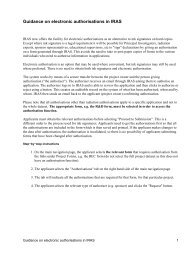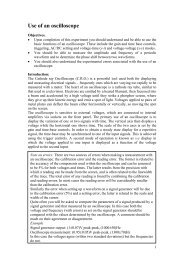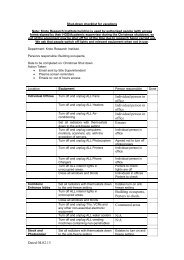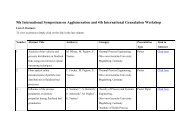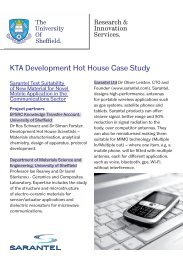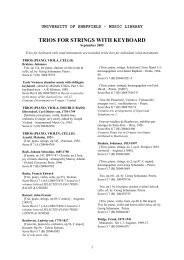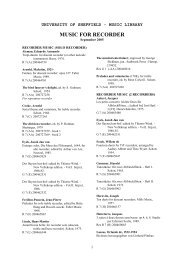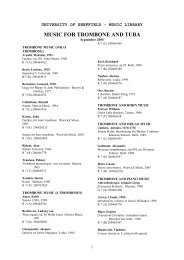- Page 1: Huron Technical Manual Software ver
- Page 5: Copyright © 1995-2003 Lake Technol
- Page 9: FCC Declaration (USA only) for Huro
- Page 13 and 14: Table of Contents DISCLAIMER.......
- Page 15 and 16: TABLE OF CONTENTS FEATURES ........
- Page 17 and 18: TABLE OF CONTENTS OPERATION .......
- Page 19 and 20: TABLE OF CONTENTS DC BLOCK.........
- Page 21 and 22: TABLE OF CONTENTS THE 96KHZ EQ ....
- Page 23: Introduction to the Huron Thank you
- Page 26 and 27: Features Applications Note: Any ISA
- Page 28 and 29: INTRODUCTION TO THE HURON • Optio
- Page 30 and 31: Installing New Hardware Components
- Page 32 and 33: ↓ To change the ISA memory addres
- Page 36 and 37: ↓ Connecting ADAT I/O Adding Addi
- Page 38 and 39: Huron Programming Tools Lake Softwa
- Page 40 and 41: ↓ Changes to the Windows 2000 Env
- Page 43 and 44: Introduction Features The VRack Too
- Page 45 and 46: Checking Configuration ↓ To check
- Page 47 and 48: Tip: Channel Names are saved along
- Page 49 and 50: ↓ To save a workspace under a new
- Page 51 and 52: Introduction Features Operation Sta
- Page 53 and 54: Valid Patching ↓ To de-select a s
- Page 55: ↓ To pin a patchset ↓ To unpin
- Page 58 and 59: Operation Starting ↓ To access th
- Page 60 and 61: Viewing Digital Input Status ↓ To
- Page 62 and 63: Removing Channels from a Group ↓
- Page 65 and 66: Introduction to the Simulation Tool
- Page 67 and 68: An overview of the Simulation Tools
- Page 69 and 70: THE SIMULATION TOOLS Soundscape thr
- Page 71: Calibrating Speaker Arrays THE SIMU
- Page 74 and 75: Starting ↓ To access BinScape Edi
- Page 76 and 77: Source name Primary location channe
- Page 78 and 79: Custom Head Filter Specifications C
- Page 80 and 81: Starting ↓ To access the Space Ar
- Page 82 and 83: Removing an Object ↓ To remove th
- Page 84 and 85:
Placing the Observer ↓ To adjust
- Page 86 and 87:
Adding Room Reverberation ↓ To ad
- Page 89 and 90:
Features Operation AniScape The Ani
- Page 91 and 92:
Features Operation Starting The Sou
- Page 93 and 94:
Note: The first two elements in the
- Page 95 and 96:
Adding Room Reverberation ↓ To ad
- Page 97 and 98:
Features Operation Starting ↓ To
- Page 99 and 100:
Adding and Editing a Listener ↓ T
- Page 101 and 102:
Features Operation Starting The Bin
- Page 103 and 104:
Selecting and Changing a Head Relat
- Page 105 and 106:
Features Operation MultiScape The M
- Page 107 and 108:
Figure 36 — The MultiScape add so
- Page 109 and 110:
Figure 37 — MultiScape add speake
- Page 111 and 112:
Adding Editing and Removing Headpho
- Page 113 and 114:
Room Map Function ↓ To access the
- Page 115 and 116:
No Room simulation ↓ To select No
- Page 117 and 118:
Features Operation HeadScape HeadSc
- Page 119 and 120:
Figure 42 — HeadScape’s add ERT
- Page 121 and 122:
HURON1 3840 0.0 0 1.5 0 3.0 0 4.5 0
- Page 123 and 124:
Features Operation Sonic Animator S
- Page 125 and 126:
Starting ↓ To create a new scene
- Page 127 and 128:
↓ To import a Locator script ↓
- Page 129 and 130:
↓ To change a track’s propertie
- Page 131:
External MTC Synchronisation ↓ Co
- Page 135 and 136:
Features The Locator The Locator to
- Page 137 and 138:
Moving a Listener Object or Sound O
- Page 139:
↓ To record a Locator Script Summ
- Page 142 and 143:
Hardware Connection ↓ Note: When
- Page 144 and 145:
Starting ↓ To access WavePlayer-2
- Page 146 and 147:
Optimising System Performance ↓ A
- Page 148 and 149:
Starting ↓ To access the WavePlay
- Page 151 and 152:
Features Make Room Make Room is a v
- Page 153 and 154:
↓ To select an Output mode Select
- Page 155 and 156:
↓ To set the sample rate ↓ To s
- Page 157:
↓ To generate the impulse signals
- Page 160 and 161:
Initialisation SNAP Commands Genera
- Page 162 and 163:
AniScape Commands Parameter Descrip
- Page 164 and 165:
OTHER SIMULATION TOOLS SNAPGetSourc
- Page 166 and 167:
OTHER SIMULATION TOOLS SNAPMultiSet
- Page 168 and 169:
OTHER SIMULATION TOOLS This command
- Page 170 and 171:
OTHER SIMULATION TOOLS SNAPVMxGetIn
- Page 172 and 173:
Parameter Description OTHER SIMULAT
- Page 174 and 175:
WavePlayer Commands Parameter Descr
- Page 176 and 177:
OTHER SIMULATION TOOLS in long lWav
- Page 178 and 179:
Locator Commands General Commands S
- Page 180 and 181:
Note: All doors should have at leas
- Page 183:
Introduction to the Engineering Too
- Page 186 and 187:
Figure 52 — Overview of the Convo
- Page 188 and 189:
↓ To select the type of filter to
- Page 190 and 191:
↓ To remove a FIR filter from the
- Page 192 and 193:
Summary THE ENGINEERING TOOLS When
- Page 194 and 195:
96kHz Filters Filter Type Number Fi
- Page 197 and 198:
Introduction Features Operation The
- Page 199 and 200:
Inputs ↓ To change the number of
- Page 201 and 202:
Generating Test Signals ↓ To crea
- Page 203:
Summary THE ENGINEERING TOOLS • T
- Page 206 and 207:
THE ENGINEERING TOOLS • 1 96kHz D
- Page 209:
Introduction to the SIM Tools The S
- Page 212 and 213:
THE ENGINEERING TOOLS • Most Lake
- Page 214 and 215:
THE ENGINEERING TOOLS Menu Item Con
- Page 216 and 217:
↓ To convert or create a SIM file
- Page 218 and 219:
↓ To display the magnitude of a c
- Page 221:
Cutvec Windows Interface ↓ To sta
- Page 224 and 225:
↓ To produce overlap ↓ To trans
- Page 226 and 227:
↓ To generate a window function
- Page 228 and 229:
↓ To generate a noise signal ↓
- Page 230 and 231:
THE ENGINEERING TOOLS 6. Type the l
- Page 232 and 233:
THE ENGINEERING TOOLS 6. Type the f
- Page 234 and 235:
Figure 77 — The Plotwsim main int
- Page 236 and 237:
↓ To set up a printer Note: The f
- Page 238 and 239:
↓ To change the range of the X ax
- Page 241 and 242:
Introduction Features Operation ↓
- Page 243:
Usage Wavtosim Wavtosim is a comman
- Page 247 and 248:
Introduction Uniform Window Bartlet
- Page 249:
Blackman-Harris Window a( 0) = 0. 3
- Page 253 and 254:
Features Applications Introduction
- Page 255 and 256:
THE EQUALISATION TOOLS Menu Item Co
- Page 257 and 258:
Loading EQ Canvasses ↓ To load a
- Page 259 and 260:
↓ To move a Slider ↓ To adjust
- Page 261 and 262:
↓ To select a filter length 1. Se
- Page 263 and 264:
↓ To zoom into a section of canva
- Page 265:
↓ To set Lake EQ to use Optimum P
- Page 268 and 269:
96kHz Filters THE EQUALISATION TOOL
- Page 271:
Other Tools This section introduces
- Page 274 and 275:
Starting ↓ To access the VMixer
- Page 276 and 277:
↓ To adjust the gain of an audio
- Page 278 and 279:
Controlling VMixer Remotely Summary
- Page 280 and 281:
↓ To select which pair of inputs
- Page 282 and 283:
Altering the XYZ Balance ↓ To alt
- Page 285 and 286:
Operation Starting ↓ To access I/
- Page 287 and 288:
Testing Signal to Noise Ratios ↓
- Page 289:
Huron Technical Reference The Huron
- Page 292 and 293:
HURON TECHNICAL REFERENCE files tha
- Page 295 and 296:
Huron Technical Specifications 16 B
- Page 297 and 298:
Figure 101 — Frequency Response o
- Page 299:
D-62 Connector Specifications HURON
- Page 302 and 303:
HURON TECHNICAL REFERENCE • Alway
- Page 304 and 305:
↓ To achieve the best results in
- Page 306 and 307:
Binaural HRTF HURON TECHNICAL REFER
- Page 308 and 309:
Linear Phase HURON TECHNICAL REFERE
- Page 311 and 312:
VRack Autostart ↓ To auto-start V





